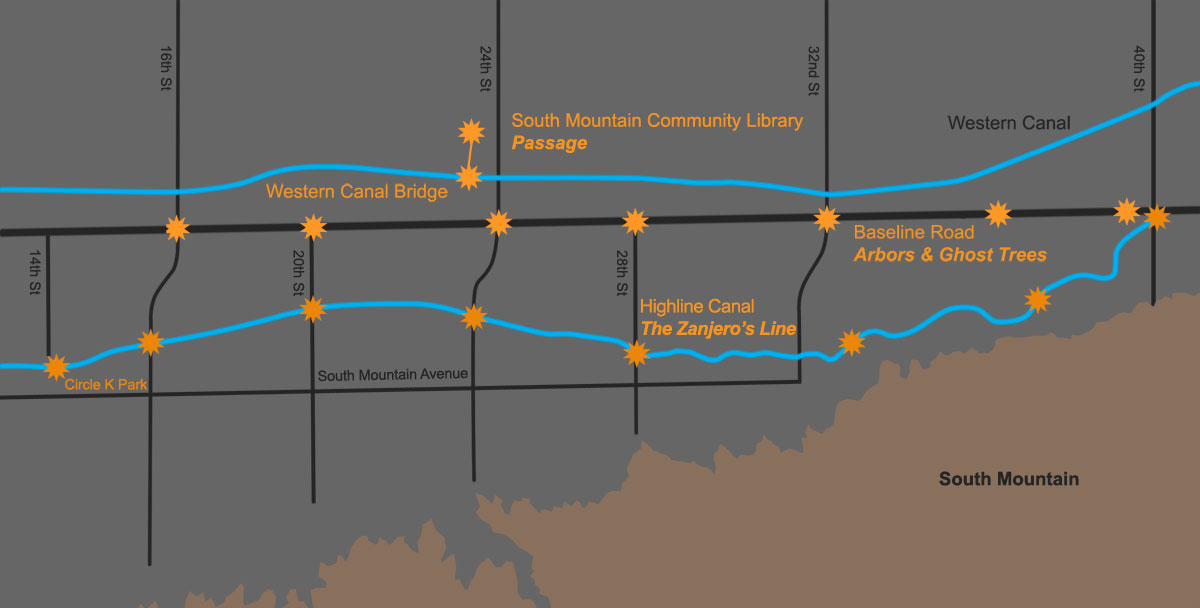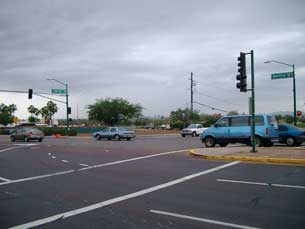- Location: Baseline Road, South Mountain Village, Phoenix, AZ (2004)
- Client: Phoenix Office of Arts & Culture
- Size: 13 sites, 75′ x 12′ x 12′ each
- Material: Steel, fiberglass, desert planting
- Budget: $285,000 Artist-made; approx. $1,100,000 artist designed, contractor-made
- Funded: % for Art & Transportation Bonds
- Landscape Architect: Ten Eyck Landscape Architects
Arbors & Ghost Trees

Map showing the art sites of Passage, The Zanjero’s Line, and Arbors & Ghost Trees in South Phoenix
This public art pathway project was the first phase of the Multi-Use Trail System in South Phoenix, which is rapidly transforming from an agricultural area of citrus groves and flower farms into residential neighborhoods. This improvement project includes our other public artworks The Zanjero’s Line (2009) and Passage (2011).
Arbors & Ghost Trees provides substantial areas of shade and greenery with Arbors and Bus Shelters at all of the major corners along Baseline Road. They also serve as catalysts for community identity.

Baseline Road
Arbors & Ghost Trees was a part of a much larger undertaking to improve and reconstruct 4 miles of Baseline Road, a major transit artery. The artists worked as part of a design team with the engineers for the Street Transportation Department and were supported by Ten Eyck Landscape Architects. The project encompasses the whole 4 miles of the road with newly planted trees arranged in a diagonal grid on both sides of the road and planting in large, bold blocks of color that reference the flower farms of the region. The overall design focuses on the transition of colors and patterns between each site along the road.

Overall plan showing plantings and color scheme
The Arbors
The forms of the Arbors and Shelters are derived from the greenhouses of the vanishing Japanese-owned flower farms that once thrived in the area. Flowering bougainvillea will grow to cover the arbors, creating green shaded tunnels along Baseline Road.
Seats, Shelters & Histories
The fiberglass roof panels of the shelters are made in four bright colors: blue, yellow, organe, and red. The panels contain images of different fruit and flowers once grown in region. During the day the translucent panels glow with color in the sunlight. At night, specially designed solar-powered lighting casts light on the panels, so that the shelters glow from the inside.
Cast tractor seats with logos of the South Mountain Community reference the region’s agricultural past. Steel inserts in the pavement give the appearance of plows raking the concrete walkways.
The Ghost Trees
The Ghost Trees are grouped in grids at the main street corners. They are memories of the area’s old citrus orchards. Once the irrigation water was turned off the trees died, but remained standing in their orderly grids. The piece is not a sentimental memorial but a marker of the major changes taking place in the area.
Functional Icon
Although the pieces of each site are functional their designs conceptually explore the history of the South Mountain area, offering layers of experience to their users. They create an icon for the area that can be apart of residents’ everyday routines.
